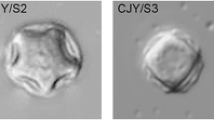Abstract
Acanthamoeba are found in the environment, particularly in water, all over the world. The genus is currently classified into 20 different genotypes, T1–T20. In this study, 63 natural water samples from 11 provinces in northeast Thailand were collected and cultured on non-nutrient agar plates. Positive samples by culture were subsequently analyzed by molecular methods. The identification of Acanthamoeba was based on morphological features and molecular techniques using PCR and DNA sequencing. The results showed that 10 samples out of 63 were positive (15.9 %). Phylogenetic analysis revealed that seven samples were T4, one sample was similar to T3, and the other two samples were similar to T5. This is the first report demonstrating the contamination of Acanthamoeba species in natural water sources in northeast Thailand.




Similar content being viewed by others
References
Booton GC, Visvesvara GS, Byers TJ, Kelly DJ, Fuerst PA (2005) Identification and distribution of Acanthamoeba species genotypes associated with nonkeratitis infections. J Clin Microbiol 43(4):1689–1693
Fuerst PA, Booton GC, Crary M (2015) Phylogenetic analysis and the evolution of the 18S rRNA gene typing system of Acanthamoeba. J Eukaryot Microbiol 62:69–84
Jongwutiwes S, Pariyakanok L, Charoenkorn M, Yagita K, Endo T (2000) Heterogeneity in cyst morphology within isolates of Acanthamoeba from keratitis patients in Thailand. Trop Med Int Health 5(5):335–340
Khan NA (2006) Acanthamoeba: biology and increasing importance in human health. FEMS Microbiol Rev 30:564–595
Koltas IS, Eroglu F, Erdem E, Yagmur M, Tanir F (2015) The role of domestic tap water on Acanthamoeba keratitis in non-contact lens wearers and validation of laboratory methods. Parasitol Res 114(9):3283–3289
Laummaunwai P, Ruangjirachuporn W, Boonmars T (2012) A simple PCR condition for detection of a single cyst of Acanthamoeba species. Parasitol Res 110:1569–1572
Lekkla A, Sutthikornchai C, Bovornkitti S, Sukthana Y (2005) Free-living ameba contamination in natural hot springs in Thailand. Southeast Asian J Trop Med Public Health 36(Suppl 4):5–9
Maghsood AH, Sissons J, Rezaian M, Nolder D, Warhurst D, Khan NA (2005) Acanthamoeba genotype T4 from the UK and Iran and isolation of the T2 genotype from clinical isolates. J Med Microbiol 54(Pt 8):755–759
Mahmoudi MR, Rahmati B, Seyedpour SH, Karanis P (2015) Occurrence and molecular characterization of free-living amoeba species (Acanthamoeba, Hartmannella, and Saccamoeba limax) in various surface water resources of Iran. Parasitol Res 114(12):4669–4674
Marciano-Cabral F, Puffenbarger R, Cabral GA (2000) The increasing importance of Acanthamoeba infections. J Eukaryot Microbiol 47(1):29–36
Nacapunchai D, Kino H, Ruangsittichai C, Sriwichai P, Ishih A, Terada M (2001) A brief survey of free-living amebae in Thailand and Hamamatsu district, Japan. Southeast Asian J Trop Med Public Health 32:179–182
Nuprasert W, Putaporntip C, Pariyakanok L, Jongwutiwes S (2010) Identification of a novel T17 genotype of Acanthamoeba from environmental isolates and T10 genotype causing keratitis in Thailand. J Clin Microbiol 48:4636–4640
Sangruchi T, Martinez AJ, Visvesvara GS (1994) Spontaneous granulomatous amebic encephalitis: report of four cases from Thailand. Southeast Asian J Trop Med Public Health 25(2):309–313
Schroeder JM, Booton GC, Hay J, Niszl IA, Seal DV, Markus MB, Fuerst PA, Byers TJ (2001) Use of subgenic 18S ribosomal DNA PCR and sequencing for genus and genotype identification of acanthamoebae from humans with keratitis and from sewage sludge. J Clin Microbiol 39(5):1903–1911
Siddiqui R, Khan NA (2012) Biology and pathogenesis of Acanthamoeba. Parasit Vectors 5:6. doi:10.1186/1756-3305-5-6
Sukthana Y, Rigunti M, Siripanth C, Kusolsuk T, Chintrakarn C, Kulpaditharom B (2005) An exotic sinusitis. Trans R Soc Trop Med Hyg 99(7):555–557
Tamura K, Stecher G, Peterson D, Filipski A, Kumar S (2013) MEGA6: Molecular Evolutionary Genetics Analysis version 6.0. Mol Biol Evol 30(12):2725–2729
Thamprasert K, Khunamornpong S, Morakote N (1993) Acanthamoeba infection of peptic ulcer. Ann Trop Med Parasitol 87(4):403–405
Todd CD, Reyes-Batlle M, Piñero JE, Martínez-Carretero E, Valladares B, Streete D, Lorenzo-Morales J, Lindo JF (2015) Isolation and molecular characterization of Acanthamoeba genotypes in recreational and domestic water sources from Jamaica, West Indies. J Water Health 13(3):909–919
Wanachiwanawin D, Booranapong W, Kosrirukvongs P (2012) Clinical features of Acanthamoeba keratitis in contact lens wearers and non-wearers. Southeast Asian J Trop Med Public Health 43(3):549–556
Wannasan A, Uparanukraw P, Songsangchun A, Morakote N (2013) Potentially pathogenic free-living amoebae in some flood-affected areas during 2011 Chiang Mai flood. Rev Inst Med Trop Sao Paulo 55(6):411–416
Acknowledgments
This study was supported in part by grants from the following: the Invitation research Foundation of the Faculty of Medicine, Khon Kaen University (IN59135); the Commission on Higher Education; and the Thailand Research Fund (TRG5780034).
Author information
Authors and Affiliations
Consortia
Corresponding author
Rights and permissions
About this article
Cite this article
Thammaratana, T., Laummaunwai, P., Boonmars, T. et al. Isolation and identification of Acanthamoeba species from natural water sources in the northeastern part of Thailand. Parasitol Res 115, 1705–1709 (2016). https://doi.org/10.1007/s00436-016-4911-y
Received:
Accepted:
Published:
Issue Date:
DOI: https://doi.org/10.1007/s00436-016-4911-y



